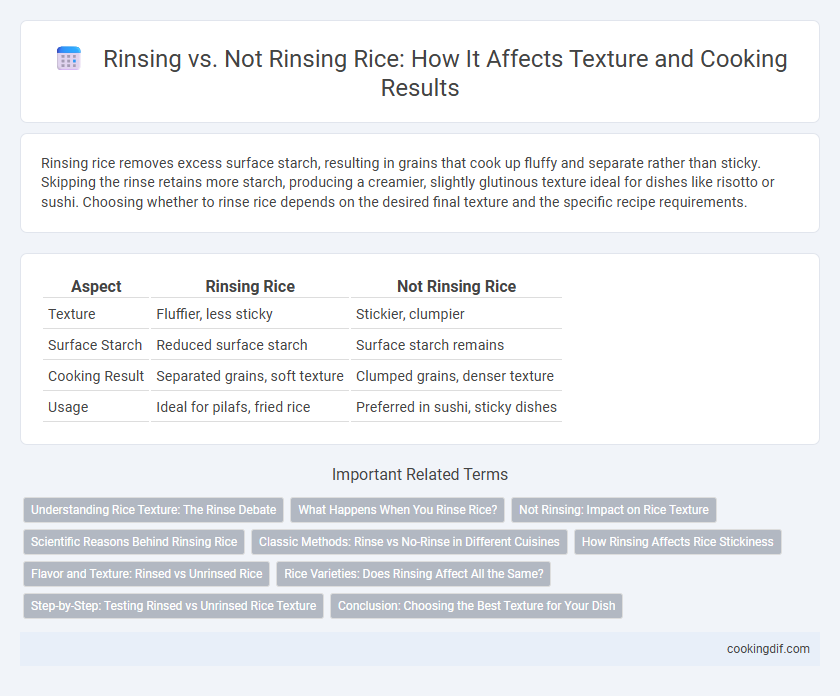Rinsing rice removes excess surface starch, resulting in grains that cook up fluffy and separate rather than sticky. Skipping the rinse retains more starch, producing a creamier, slightly glutinous texture ideal for dishes like risotto or sushi. Choosing whether to rinse rice depends on the desired final texture and the specific recipe requirements.
Table of Comparison
| Aspect | Rinsing Rice | Not Rinsing Rice |
|---|---|---|
| Texture | Fluffier, less sticky | Stickier, clumpier |
| Surface Starch | Reduced surface starch | Surface starch remains |
| Cooking Result | Separated grains, soft texture | Clumped grains, denser texture |
| Usage | Ideal for pilafs, fried rice | Preferred in sushi, sticky dishes |
Understanding Rice Texture: The Rinse Debate
Rinsing rice removes surface starch, resulting in fluffier, less sticky grains, while not rinsing preserves starch for creamier, stickier texture, ideal for dishes like risotto. The decision depends on desired rice texture and recipe requirements, as rinsed rice tends to separate after cooking, enhancing clarity and individual grain distinction. Understanding the impact of rinsing helps optimize texture for various culinary outcomes, balancing starch content and moisture absorption.
What Happens When You Rinse Rice?
Rinsing rice removes surface starch, which prevents grains from clumping and results in a fluffier texture. Without rinsing, excess starch causes rice to become sticky and gummy during cooking. The practice of rinsing also helps eliminate impurities and reduces residual pesticides, enhancing the rice's overall quality and taste.
Not Rinsing: Impact on Rice Texture
Not rinsing rice retains the surface starch, resulting in a stickier and creamier texture ideal for dishes like risotto or sushi. This method enhances the rice's ability to clump together, which is desirable for certain culinary styles. However, not rinsing may also result in slightly cloudier cooking water due to the higher starch content.
Scientific Reasons Behind Rinsing Rice
Rinsing rice removes surface starches that cause grains to clump together, resulting in a fluffier texture with separate grains. It also eliminates potential contaminants like dust, pesticides, and excess minerals, improving the purity and safety of the rice. Scientific studies reveal that rinsing affects water absorption rates and gelatinization of starch, influencing the final mouthfeel and cooking consistency.
Classic Methods: Rinse vs No-Rinse in Different Cuisines
Rinsing rice removes excess surface starch, resulting in fluffier grains favored in cuisines like Japanese and Indian, where texture clarity is essential. No-rinse methods retain more starch, producing stickier rice preferred in dishes such as risotto or certain Chinese recipes that require cohesive grains. Different classic cooking traditions tailor rinsing practices to achieve distinctive textures aligned with cultural taste profiles and dish requirements.
How Rinsing Affects Rice Stickiness
Rinsing rice removes excess surface starch, which significantly reduces stickiness and prevents clumping during cooking. Unrinsed rice retains more starch, resulting in a stickier, softer texture ideal for dishes like sushi or risotto. Optimal rinsing methods involve multiple washes until the water runs clear, enhancing the grain's separation and firmness.
Flavor and Texture: Rinsed vs Unrinsed Rice
Rinsing rice removes surface starch, resulting in fluffier, separate grains that enhance texture but can slightly reduce its natural nutty flavor. Unrinsed rice retains the starch, producing a stickier, creamier texture with a more pronounced, sweet aroma that some dishes benefit from. Choosing rinsed or unrinsed rice depends on desired dish outcomes, such as fluffy pilafs versus creamy risottos.
Rice Varieties: Does Rinsing Affect All the Same?
Rinsing affects rice texture differently across varieties; for example, rinsing long-grain rice like Basmati removes surface starch, resulting in fluffier grains, while rinsing short-grain varieties like Sushi rice reduces stickiness. Aromatic rice types lose some fragrance when rinsed, altering their characteristic aroma and flavor. Parboiled rice typically requires less rinsing due to its processing, maintaining texture and nutrient retention even without washing.
Step-by-Step: Testing Rinsed vs Unrinsed Rice Texture
Rinsing rice removes excess surface starch, leading to grains that cook up firmer and less sticky, which is ideal for dishes requiring distinct grain separation. Unrinsed rice retains more starch, resulting in a softer, slightly stickier texture preferred in recipes like risotto or sushi. Testing rinsed versus unrinsed rice by cooking identical portions side-by-side reveals clear differences in texture and moisture absorption, guiding optimal preparation based on the desired culinary outcome.
Conclusion: Choosing the Best Texture for Your Dish
Rinsing rice removes excess surface starch, resulting in fluffier, less sticky grains that are ideal for dishes like pilafs and stir-fries. Not rinsing preserves the starch, creating a creamier, stickier texture perfect for risottos and sushi. Selecting the best texture depends on the desired consistency and style of the final dish, ensuring optimal flavor and mouthfeel.
Rinsing vs not rinsing for texture Infographic

 cookingdif.com
cookingdif.com